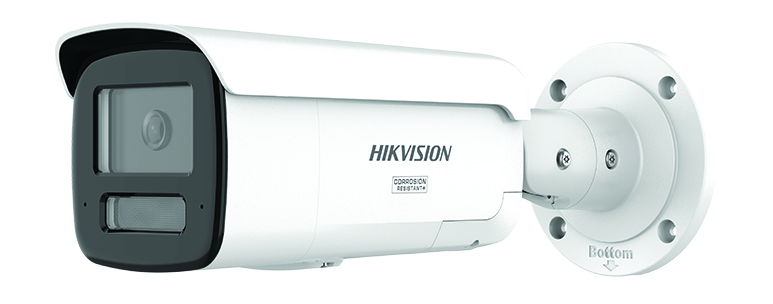
The Hikvision DS-2CD2T87G3-LIS2UY is a fixed bullet style camera that uses their ColorVu 3.0 technology to provide detailed 24-hour colour images in very low light conditions. Two-way wired or device derived audio is supported along with alarm in and out handling. Its NEMA 4X rated anti-corrosion housing should provide product longevity along with its IP67 environmental protection against water and dust ingress.
Smart lighting provides warm-white or infrared illumination in three different modes, with a strobe and audio alarm feature to potentially deter intruders.
Getting started
The camera has a short flying lead consisting of an RJ45 network connector, a 12v power jack, a 4-way audio connector, and an eight-core alarm lead. The camera is PoE capable (maximum 18W stated) or 12V DC (maximum 18W). In PoE tests at 53V, the camera generally consumed around 13W in day mode and 14W with white lights illuminated and no audio or alarm conditions.
The supplied camera did not have DHCP on by default so had its standard 192.168.1.64 IP address. The simplest way to initially access the camera is using the recommended Hikvision SADP software which allows you to discover such devices on a network rather than changing PC or network addressing. The SADP software that can be downloaded from the Hikvision.com website allows you to activate the camera, set a suitably secure admin password and change the camera’s IP address to suit the destination network. Once set, the camera’s web server can be connected to, using a standard browser.
At first connection, a graphic welcome screen prompts you to log in with your new admin credentials and you are then presented with the live view. An initial message box gives you the option to disable audio input in case this is not permitted on the target site. On the display a jigsaw piece icon can be activated to download a browser plug-in to improve the display capability. A PTZ function panel appears to the left of the image window, but this can be minimised as these functions are not supported by the camera. It was noted that this panel re-appears each time the Live View is selected, also the camera reverted to displaying the Sub-Stream until the browser plug-in was installed.
A physical reset button is available beneath the camera’s micro-SD card cover to provide a full factory reset. Once actioned the camera’s built-in speaker announces “Resetting succeeded” in a female US accent. The card cover is secured by two captive hex screws and includes a retaining strap. Cards can be up to 512GB for local storage of events.
The inbuilt mounting bracket has adjustments to pan, tilt and rotate the camera position. Overall dimensions are approximately 287 x 94 x 92mm with a mounting plate diameter of 105mm. Weight is ~1.25kg.
Menu options
This camera supports a slightly more artistic representation of menu options than has been used on earlier Hikvision products with additional graphical representations of some features.
From the browser the Live View, VCA, Configuration, and Maintenance and Security pages can be selected by left hand side icons and these options list their functions at the left of the main window as follows:
Live View: Stream selection, Capture, Record, Audio on/off, Two-way audio, Picture size, Full screen.
VCA: Smart Event, Face Capture, or Monitoring. Changing between modes will force a reboot.
Configuration: System, Network, Video/Audio, Image, Storage, Event.
Maintenance and Security: Restart, Upgrade, Backup & Restore, Log, Security Audit Log, Debugging.
Initial time settings were for GMT +8 (Beijing time zone) and US format date display, so UK region, an NTP time reference and conventional DD-MM-YYYY display need to be set in the Video and OSD pages for UK use.
The main stream can be set from 1280 x 720 up to 3840 x 2160 in five steps. The Sub-stream can be 640 x 360, 640 x 480, or 1280 x 720.
AI based detection of verified persons or vehicles can be used to sound an alarm or give an audio prompt from the camera or via the audio line out feed. Such prompts can use an uploaded .wav mono sound file if it is less than 512 kB with an 8 kHz sampling rate. Additionally, the front LED lighting can be used to flash a visible warning. The two alarm outputs can be used to trigger external equipment, lighting or sirens.
A range of network security features are provided including both IP and MAC address filtering with Block and Allow lists. General Help files can be accessed from the Web viewer pages.
Read the full review in the May 2025 edition of PSi magazine

